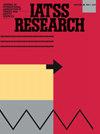Quantifying the road network structure and its impact on road traffic crashes: A Bayesian CAR modelling approach
IF 3.3
Q3 TRANSPORTATION
引用次数: 0
Abstract
Road traffic crashes (RTCs) are a major cause of fatalities worldwide. However, the influence of the road network structure on RTCs has not been adequately explored. Furthermore, methodologies employed in earlier studies to quantify road networks have often relied on visual inspection, which is both subjective and impractical. Therefore, this study aimed to address these gaps by (1) utilizing graph theory metrics to quantify the road network structure and (2) developing a statistical model to determine how various characteristics of the network structure—such as connectivity, density, complexity and centrality—are correlated with RTCs while accounting for over-dispersion and spatial auto-correlation. Using a Bayesian conditional auto-regressive model, a spatial analysis of fatal RTCs was conducted at the ward level in Delhi, India. The findings demonstrated a significant positive association between road network connectivity and fatal crash risk. Areas with a higher density of intersections involving major roads were linked to a greater number of fatal crashes. Furthermore, areas with a higher number of intersections deviating from the typical 90-degree angle (higher skewness) were associated with a higher incidence of fatal RTCs. Conversely, an efficient network structure (lower circuitry) and higher network centrality were negatively correlated with fatal RTCs. In addition, wards with a mix of higher-category and lower-category roads (increased entropy) faced an increased risk of fatal crashes. In summary, this study underscores the significant impact of network structure on road safety outcomes. Based on the findings, the study offers policy recommendations for developing targeted road safety measures to address the issues identified via network analysis.
量化道路网络结构及其对道路交通碰撞的影响:贝叶斯CAR建模方法
道路交通碰撞是世界范围内造成死亡的一个主要原因。然而,路网结构对rtc的影响尚未得到充分的探讨。此外,早期研究中用于量化道路网的方法往往依赖于目视检查,这既主观又不切实际。因此,本研究旨在通过(1)利用图论度量来量化道路网络结构;(2)建立一个统计模型来确定网络结构的各种特征(如连通性、密度、复杂性和中心性)如何与rtc相关,同时考虑到过度分散和空间自相关。使用贝叶斯条件自回归模型,对印度德里病区的致命rtc进行了空间分析。研究结果表明,道路网络连接与致命碰撞风险之间存在显著的正相关关系。涉及主要道路的十字路口密度较高的地区与更多的致命车祸有关。此外,偏离典型90度角的十字路口数量越多(偏度越高),致命rtc的发病率就越高。相反,有效的网络结构(较低的电路)和较高的网络中心性与致命的rtc呈负相关。此外,混合了高类别和低类别道路(增加熵)的病房面临着致命车祸的风险增加。总之,本研究强调了网络结构对道路安全结果的显著影响。根据调查结果,该研究为制定有针对性的道路安全措施提供了政策建议,以解决通过网络分析确定的问题。
本文章由计算机程序翻译,如有差异,请以英文原文为准。
求助全文
约1分钟内获得全文
求助全文
来源期刊

IATSS Research
TRANSPORTATION-
CiteScore
6.40
自引率
6.20%
发文量
44
审稿时长
42 weeks
期刊介绍:
First published in 1977 as an international journal sponsored by the International Association of Traffic and Safety Sciences, IATSS Research has contributed to the dissemination of interdisciplinary wisdom on ideal mobility, particularly in Asia. IATSS Research is an international refereed journal providing a platform for the exchange of scientific findings on transportation and safety across a wide range of academic fields, with particular emphasis on the links between scientific findings and practice in society and cultural contexts. IATSS Research welcomes submission of original research articles and reviews that satisfy the following conditions: 1.Relevant to transportation and safety, and the multiple impacts of transportation systems on security, human health, and the environment. 2.Contains important policy and practical implications based on scientific evidence in the applicable academic field. In addition to welcoming general submissions, IATSS Research occasionally plans and publishes special feature sections and special issues composed of invited articles addressing specific topics.
 求助内容:
求助内容: 应助结果提醒方式:
应助结果提醒方式:


